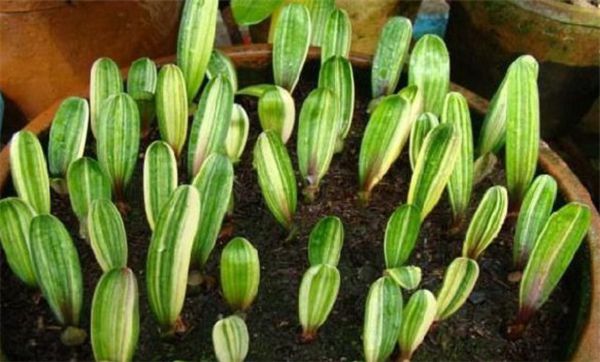Control measures of rotten leaves of Cymbidium

Gentleman orchid as its name is like a modest gentleman, growing up is particularly attractive, no matter when it is blooming or not, it is a very good ornamental plant, many people like to raise a pot, its leaves are green, flowering clusters, attractive. However, when raising orchids, we will encounter a lot of unsatisfactory places, for example, the leaves of orchids turn yellow, but it is more common.
The gentleman orchid plant shape is dignified, the leaf arrangement is neat, the leaf color is greenish and moist, it is known to watch the flowers rather than appreciate the leaves, it is a kind of flowers that people like to breed very much. So do you know how to choose a gentleman orchid? Let's take a look at the selection skills of gentleman orchid with the editor. To evaluate the quality of Cymbidium varieties, its leaves account for a large proportion. So what are the characteristics of the leaves of the top-grade magnolia? 1. The leaves of the top-grade magnolia should be short and wide, with a length of between 9 cm and 12 cm, the ratio of length to width within 4:1, and some varieties can reach 2:1 or even 1:1, such as Henglan.
Gentleman orchid is suitable to live in a humid environment, if the light is relatively strong will make the leaves more rough, but also affect its ornamental. Sometimes, we will see that the gentleman orchid has rotten leaves, many friends are worried about how to solve, the following editor will introduce to you.
First, gentleman orchid exposed to strong light for a long time, not only the leaves become rough, lose emerald green, but also often easy to get "sunburn", so that the leaves suddenly turn yellow and dry, serious whole leaves turn yellow. So summer noon around two or three hours of shade, once the leaves have turned yellow, the leaves can be cut off to urge the leaves again.
Second, if the fertilizer and water is too big and thick, poor leaf cleaning, or mold infection will lead to rotten leaves. The leaves began to rot from the base, heart, or outside of the leaves, and in severe cases, all the leaves rotted away in five or six days. It is necessary to timely control water and apply fertilizer properly to make the basin soil moist up and down. After finding rotten leaves, cut off the rotten leaves immediately, then sprinkle them with oxytetracycline powder around the rotten leaves, thoroughly, put them in a ventilated and transparent place.
Third, when the temperature rises to more than 25 ℃, the growth of the gentleman is restrained. If you continue to apply fertilizer, the leaves will grow weak and grow, resulting in unhealthy plants, and even rotten roots and stems. Too much fertilizer will cause the new leaves to curl up suddenly. It is necessary to change the soil or continue to pour water several times so that the thick fertilizer can be washed away and diluted.
Fourth, during the Meiyu period, excessive humidity, poor ventilation and hot temperature will wither the leaves and weaken their resistance to diseases. Exchange spray with 0.1% carbendazim and topiramate, once every 10 days.
Fifth, too much watering will cause the roots to rot, and the leaves will gradually wither and fall off from the bottom up. It is necessary to dig up the plants and wash out the soil, cut off the rotten roots, and dry them for four or five days, so that the roots contract slightly, and then put them back on the basin. If half of the water is often watered, the root system will be withered and the leaves will wither and fall off from the bottom up, so it should be watered thoroughly in time.
6. Cymbidium is a fleshy root with weak water absorption capacity, thick leaves and high water content. if the basin soil is too wet or too dry for a long time, it will cause water reflux and the leaves will gradually blacken and rot, so it is appropriate to keep the basin soil dry. What is more important is that whether small, medium or large plants, pouring water on the leaves in the center, or often in the rain, or dripping into the center, will make the new leaves in the center rot, and in serious cases, they will rot, so don't water the orchids on the leaves, especially avoid pouring them into the center leaves.
Seventh, high temperature, fierce sun, less Rain Water, dry environment, no ventilation, or poor drainage, or the application of raw fertilizer will make the leaves scorched yellow or fall off. Use loose and dry soil, apply rotten fermented light fertilizer, and put it in a ventilated and cool environment.
Eighth, the unfermented horse dung or meat bones at the bottom of the basin are easy to produce white nematodes, making the leaves scorched yellow, so it is necessary to change the basin soil and replant.
9. There is a pockmarked macula in the center of the leaf. On the surface, it appears that the leaf is sick and infected, but in fact, there are problems in the root, such as the basin soil is too wet, or the place is stuffy and not ventilated, or the application of raw fertilizer and thick fertilizer will appear the above symptoms. If you fertilize too much, too thick or apply raw fertilizer, you should change the soil immediately, and if it is not placed properly, you should change the place to make the basin soil dry.
Due to the mold activity in the basin soil, the leaves are spotted, so formalin should be used in time. Leaf spots have appeared, which can be wiped with 1000 times oxytetracycline or tobacco stem water soaking solution to control the development of leaf spots.
Related
- Is the orchid suitable for indoor use? Is it good for the body?
- How to prevent the empty root of orchids?
- What to do after the crab claw orchid is withered?
- Why are the leaves of orchids always yellow? Fertilizing and watering.
- Can the root of the gentleman orchid be saved if it is rotten?
- Diagnosis and treatment of cotton-blowing beetle insects in Cymbidium
- There is a way for a gentleman's orchid to rot.
- What is the most suitable temperature and humidity for the orchid?
- How to raise a gentleman's orchid? Cultivation techniques of Cymbidium
- How to prepare the nutritive soil for the cultivation of Cymbidium



